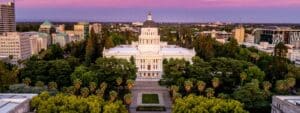This summer, the Association of Bay Area Governments and Metropolitan Transportation Commission are hosting public workshops in all nine Bay Area counties to gather input for their just-released scenarios on how to update Plan Bay Area (more on the scenarios below).
Greenbelt Alliance will be at every workshop and we urge you to join us and make your voice heard. Check the schedule of workshops for the one in your county. If you can’t attend, submit your comments online at planbayarea.org.
Updating Plan Bay Area
Plan Bay Area, adopted in 2013, lays out a groundbreaking vision for how the Bay Area should grow. It calls for creating sustainable, affordable communities and protecting our region’s iconic natural and agricultural landscapes from sprawl development. The plan must be updated every four years, and the update process puts some fundamental questions on the table:
- How should our cities and towns grow?
- How important is it to protect our open spaces?
- What more is needed to make sure our communities grow in the best way possible?
To inform these decisions, ABAG and MTC have just released three scenarios—alternative ways the Bay Area could grow over the next generation. Included are initial findings about how those scenarios would help or hurt a variety of goals such as reducing greenhouse gas emissions, improving public health, increasing housing affordability, and reducing the displacement of low-income residents. Elements from the three scenarios will be combined into a single “preferred scenario” that will form the blueprint for the updated Plan Bay Area.
Our Initial Observations
The scenarios have big differences on where growth occurs.
We’re pleased to see that two of the scenarios call for smart growth, focusing 100% of the next generation of growth inside our urban growth boundaries (UGBs) and city limits. But brace yourself: One scenario would develop 565 square miles of natural and agricultural lands outside those UGBs—paving over an area 11 times the size of San Francisco.
With so many well-documented environmental, economic, and social equity benefits of focusing growth within existing cities and towns, it’s clear what choice our region needs to make: MTC and ABAG should adopt a preferred scenario that focuses all growth within our existing communities to make them more affordable, help them thrive, and protect our open spaces from sprawl.
More is needed in all three scenarios.
Unfortunately, all three scenarios fall short on several critical issues, particularly affordability and mobility.
While each scenario includes a few strategies to provide more homes that are affordable to low-income residents, none are sufficient to tackle the housing affordability crisis and the growing displacement of low-income residents who can’t afford to remain in their communities. The preferred scenario should include a full package of policies and investments to increase housing affordability and provide community stability so that everyone can live in a neighborhood they’re proud to call home.
Likewise, the scenarios don’t include enough to make it easier to walk, bike, and take transit. That means we’re not reaching our goals for creating healthier communities and providing a full array of transportation choices for everyone. The preferred scenario should redirect transportation investments. For example, Plan Bay Area should ensure that available revenues aren’t spent on highway expansion and are instead focused on sustainable transportation options. It should also explore providing more jobs and homes closer to transit so that more people can access a quality job without a grueling commute.
What You Can Do
Attend a Plan Bay Area public workshop.
In May and June, MTC and ABAG are hosting public workshops in all nine counties to gather input on the scenarios. We encourage you to attend and make your voice heard. Let us know if you’re planning to attend at mvandersluis@greenbelt.org.
Alameda County Open House
Date: Thursday, June 2
Time: 6:30 p.m. – 8:30 p.m.
Place: MetroCenter Auditorium, 101 Eighth Street, Oakland (map)
Contra Costa County Open House
Date: Thursday, May 26
Time: 6:30 p.m. – 8:30 p.m.
Place: East Bay Center for the Performing Arts, 339 11th Street, Richmond (map)
Marin County Open House
Date: Saturday, June 4
Time: 8:30 a.m. – 1 p.m.
Place: Corte Madera Community Center, 498 Tamalpais Drive, Corte Madera (map)
Napa County Open House
Date: Thursday, June 9
Time: 6 p.m. – 8 p.m.
Place: Elks Lodge, 2840 Soscol Avenue, Napa (map)
San Francisco Open House
Date: Tuesday, June 14
Time: 6:30 p.m. – 8:30 p.m.
Place: Hotel Whitcomb, 1231 Market Street, San Francisco (map)
San Mateo County Open House
Date: Wednesday, June 1
Time: 6:30 p.m. – 8:30 p.m.
Place: City of Burlingame Recreation Center – Auditorium, 850 Burlingame Avenue, Burlingame (map)
Santa Clara County Open House
Date: Thursday, May 26
Time: 6:30 p.m. – 8:30 p.m.
Place: The Tech Museum, 201 South Market Street, San Jose (map)
Solano County Open House
Date: Monday, June 13
Time: 6 p.m. – 8 p.m.
Place: Solano County Events Center, 601 Texas Street, Fairfield (map)
Sonoma County Open House
Date: Monday, June 13
Time: 6 p.m. – 8 p.m.
Place: Luther Burbank Center for the Arts – Grand Lobby, 50 Mark West Springs Road, Santa Rosa (map)
Submit comments online.
If you can’t attend any of the public workshops, submit your comments online at planbayarea.org.
Stay informed.
Sign up to receive email updates on Plan Bay Area and other smart growth and conservation news here.
Looking Forward
After MTC and ABAG staff review the public input they receive from the workshops, they will present a preferred scenario for adoption in September. Stay tuned for more!
Photo: Daniel Hoherd via Flickr




